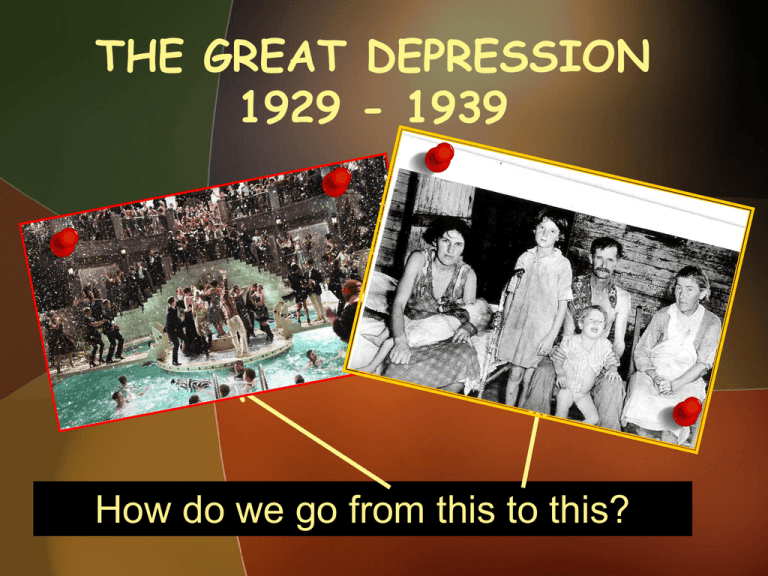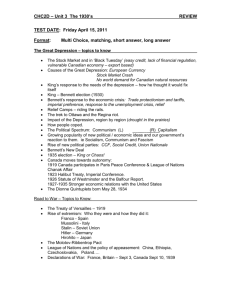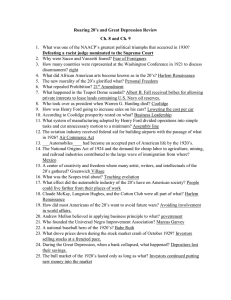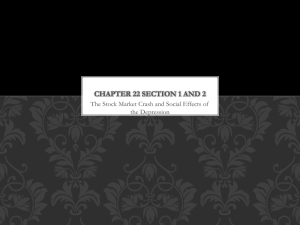Introduction to the Great Depression (Causes and
advertisement

THE GREAT DEPRESSION 1929 - 1939 An Introduction How do we go from this to this? From Boom to Bust: The Great Depression 1929-1939 “Dirty Thirties” • The Trigger: October 29th, 1929 - the good times of the 1920s abruptly came to an end when the New York Stock Market crashed, followed by stock crash in Toronto. This day in 1929 was called “Black Tuesday” (the stock crash was a symptom of other economic problems) • The 1930’s depression became a time of despair for many Canadians as they lost their savings, their jobs, their automobiles and their homes. • The Great Depression was the longest in human history (10 years) and affected Canada and the rest of the world! WHAT TRIGGERED THE GREAT DEPRESSION? •The 1929 Stock Market crash was a CONSEQUENCE of deeper economic spending problems from the 1920’s party era that triggered the 1930’s Depression. •The stock market crashed when people & banks rushed to sell their stocks at once. Prices and values dropped, profits fell, and investors lost $30billion in total. •Those who bought on credit could not repay debts. •1 out of 5 people would be unemployed during the 1930’s depression. What caused the 1930 Great Depression that lasted 10 years? Let’s play the blame game… Task: You will be placed in a group playing the part of overpaid defense lawyers. You must represent your client by BLAMING the other party for causing the Great Depression. Identify at least 3 reasons to blame the other group and be sure to explain the “significance” of how each problem they created resulted in a personal/societal/economic/or polital consequence for individuals or Canada as a whole. 1)The government & banks OR 2) Canadian citizens and prairie farmers WHAT WERE THE 5 MAIN CAUSES OF THE GREAT DEPRESSION IN CANADA? REASON 1: Irresponsible spending and limited government regulation during the 1920’s paved the way to the Stock market crash of 1929 & The Great Depression in the 1930’s: •Canadians were going into debt by the late 20’s without realizing it when times were good and living beyond their means. •Buying stocks “on the margin” (10% of price… risky if it dropped, as they were then responsible for paying the whole price at once). •Buying goods on credit and living beyond their means (what they could realistically pay for at the time of purchase). Farmers and businesses borrowed money from banks to pay for equipment and labour (loans the couldn’t repay after the stock market crash of 1929). •Consequence: Resulted in major debt for the country, banks, individuals and economic crisis. Businesses shut down & people lost savings & jobs! Basically, the stock market crash of 1929 was due to… Irresponsible spending: •People bought stocks with credit during the 20’s, which allowed them to easily invest in the stock market (purchasing margin shares for 10% of the entire price of the stock was risky if stock goes down). •Limited government regulation, laissez-fair approach enabled people to buy/sell easily without thinking of whether they could afford their purchases. • Limited regulation enabled people to use credit to live beyond their means, take out loans, spend unwisely, and accumulate large debts. REASON 2. Businesses were producing more goods than they could actually sell. •Industries in the 1920’s were expanding (with the change from a war based industry to a consumer based industry… building cars and small appliances instead of guns). •Profits were spent on adding to factories or building new ones during prosperity. •HOWEVER, this MASS PRODUCTION of consumer products (like cars, consumer goods, etc) resulted in a huge stockpile supply of goods that couldn’t all be sold by the late 20’s. •In other words, there was an over-supply of products with not enough demand for them (consumers were not buying enough of what was being made and sold by companies). REASON 3. Canada was too dependent on exports of natural resources (selling to other countries). Overproduction of raw materials and the limited demand for products became a big problem! •With the prosperous 1920’s, Europe was starting to recover after WWI and make their own consumer goods like Canada. •They no longer needed Canada to export products like wheat, paper, fish, coal or consumer products (this added to the oversupply build-up problem of consumer products in the late 20’s and little demand or need for all those products that were manufactured in bulk)… leading to the 1930 depression/debt/poverty. REASON 4. Canada’s economy was also too dependent on the USA. In the 1920’s, almost 40% of Canadian exports were sold to the States, along with investments. When the US economy failed with the Stock Market Crash of 1929, Canada’s stock market followed with devastating consequences, leading to mass poverty and unemployment. Protectionism tarrifs made this problem worse… 1920’s tariffs (duties or taxes on imported goods coming into a country) hurt Canadian profits when exporting/selling to other countries. US protectionist taxes really hurt Canadian business profits when exporting/selling to the States. REASON 5. The Dust Bowl HIT HARD •Wheat prices hit rock bottom without having anyone to export to. Farmers lost their business in the prairies. Land was also destroyed by over ploughing in the 20’s during prosperity. •To make matters worse, farmers took a hard hit with the Dust Bowl (severe drought hit farms). •Farmers abandoned their farms and hopped on trains illegally to hitch a ride for work elsewhere. The effects of the depression were made worse by the Dust Bowl Decades of over-farming and droughts in the Plains led to windstorms that swept away soil and made farming impossible • CONSEQUENCES!!!! Major Consequences: • Consequence: Resulted in major debt for the country, banks and businesses closed, individuals and the economy were in major economic /emotional/social crisis. • Businesses shut down & people lost savings & jobs! • Massive unemployment throughout the 1930’s (about 25%-30% of the population were unemployed) • People were afraid to buy anything How you viewed the Great Depression depended on your age and what happened to you. Children: • Never really saw this era as a miserable time • Families have a lot of time for each other • For entertainment, there were parlor games, the piano, church community, radio • Food may have been poor, but there was plenty of appetite Adults: • Many were unable to find a job or pay the rent • Once your savings were gone, there was nothing else • Fishermen couldn't sell their fish (nobody had money to purchase it) • Farmers watched the soil blow away as dust • Young men were often the most disadvantaged Farmers often faired better than the urban dwellers because they could eat what they managed to grow (unless the dust bowl directly affected their crops out west in Canada along the prairies). -For the farmers who managed, many were already poor, so they could cope with more poverty. Store owners sometimes extended credit knowing that they may never be paid. Teachers watched out for (and often fed) students who came to school hungry. Religious institutions played a major role by: -Offering stability and comfort to families -Providing counseling for those who were overwhelmed -Shipping clothes and food to the prairies during the Dust Bowl Soup Kitchens and Breadlines – food stamps and work camps Rudy Vallee “Brother Can You Spare a Dime?” Song plays for next 4 slides Mortgage Foreclosures Poverty in America This is a Bennett Buggy – a car with the engine and windows removed and pulled by a horse. – Nicknamed after 1930’s Prime Minister Richard Bennett (blamed for not fixing the Canada’s poverty state). This is an image of men “riding the rods”. Why would men do something so dangerous? What Were the Long-term Effects of the Great Depression? • The Great Depression profoundly affected the world economy, especially in Europe, where many countries had not fully recovered from the aftermath of World War One; In Germany, the economic disaster and resulting social dislocation contributed to the rise of Adolf Hitler. • -We will discuss this further in the following weeks What Were the Long-term Effects of the Great Depression…continued • Not everyone suffered (rich corporations fired people and cut costs to keep their wealth. People who were already rich managed just fine with the cheap prices at stores). • Yet it is generally agreed that complete business recovery was not achieved and unemployment ended until the government began to spend heavily for defense during World War Two. Homework Questions: 80-81, 86-89 Consider… 1)How did Bennett respond to the Great Depression? 2)Read pages 80-81 in your textbook. Do you think it was fair to blame Bennett for the long-term effects of the Great Depression? 3)How did the Great Depression affect the following groups of people: Women, Aboriginal and First Nations, Inuit Communities? 4)What was Bennett’s New Deal? Why was it significant? Canada and the Great Depression …continued • For all the unemployed there was a relief program for families and all unemployed single men were sent packing by relief officers by boxcar to British Columbia. There were also work camps established for single men by Prime Minister Bennett's Government. • As the Depression carried on, 1 in 5 Canadians became dependent on government relief. Around 30% of the labour force was unemployed, where as the unemployment rate had previously never dropped below 12%. Summary • The era of the Great Depression (192939), also known as the “Dirty Thirties”, wasn't like an ordinary depression where savings vanished and city families went to the farm until it blew over. • The Great Depression affected everyone in some way and there was basically no way to escape it. The Socialist James S. Woodsworth told the Federal Parliament in Ottawa, "If they went out today, they would meet another army of unemployed coming back from the country to the city." Summary…continued • Many people turned to new political parties to help solve the economic crisis, as traditional political parties failed to offer any real strategies to relieve the situation. • Nothing world governments did to alleviate the economic crisis was completely successful. The employment and production demands of World War Two ended the Great Depression.



